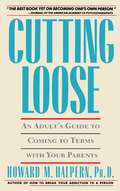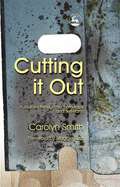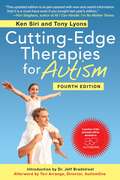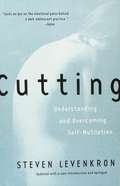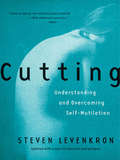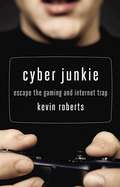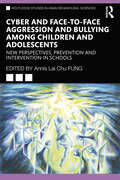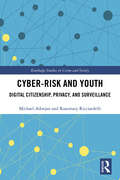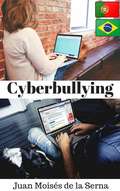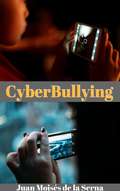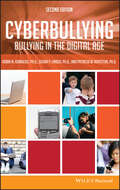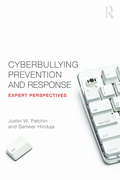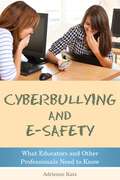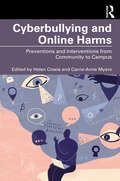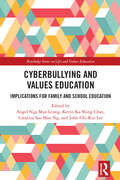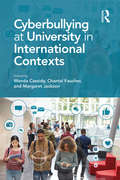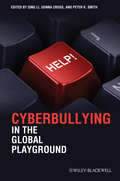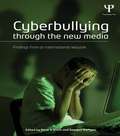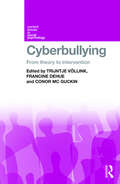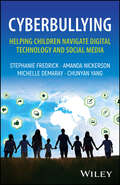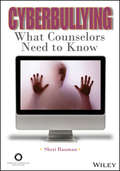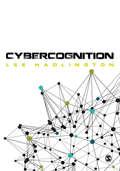- Table View
- List View
Cutting Loose: An Adult's Guide to Coming to Terms with Your Parents
by Howard HalpernWith more than 35 years of experience in psychotherapy, Dr. Halpern enables the adult child to understand his or her parent and foster a positive, healthy adult relationship.
Cutting it Out: A Journey through Psychotherapy and Self-Harm
by Maggie Turp Carolyn SmithCutting it Out is a largely autobiographical account of a young woman's battle with self-harm. Carolyn's story documents her own challenging journey, offering unique insights into her feelings about self-harming and also her attitudes towards the therapy sessions commonly employed to help people who self-harm. It explores the complex nature of her relationship with the therapist, her initial resistance to recovery and her eventual progression towards self-knowledge and taking responsibility for her own actions. The first-person narrative offers a vividly honest voice to the feelings and compulsions that drive someone to harm themselves and explores the conflict between the desire to self-harm and the struggle to control and overcome this addictive, self-destructive behaviour. This timely book breaks the silence surrounding a difficult subject. It will provide valuable insights for therapists, counsellors, people who self-harm and their families and friends.
Cutting-Edge Therapies for Autism, Fourth Edition
by Tony Lyons Teri Arranga Ken SiriThe parents of children with autism know that learning about treatments is a full-time job. For parents with limited time, ability, or resources, Ken Siri and Tony Lyons have compiled the latest in autism research and treatment. Exploring the possible causes of autism and presenting novel therapies, medications, and interventions, Cutting-Edge Therapies for Autism contains contributions from more than ninety experts on a wide variety of research findings, therapies, models, and multifaceted evaluation and treatment centers.Revised and fully updated to include the latest developments, this fourth edition includes up-to-date information on mitochondrial, antifungal, and physical therapy treatments; about speech, art, music, and sound therapies; and how diets, HANDLE, indigenous healing, and other exciting new treatments can be used to help your child. It also addresses developing technologies, like the iPad, which provides hundreds of apps that help kids with autism communicate and organize their day, and helps parents keep track of therapy schedules. Filled with case studies and research, Cutting-Edge Therapies for Autism is a detailed and informative guide for anyone affected by autism.
Cutting: Understanding and Overcoming Self-Mutilation
by Steven LevenkronLevenkron traces the components that predispose people to self-mutilation: genetics, family experience, childhood trauma, and parental behavior. Also describes how they can be helped.
Cutting: Understanding and Overcoming Self-Mutilation
by Steven Levenkron<P> A seminal work on treating self-mutilation, revised and updated with illuminating case studies and newly available resources. <P> Nearly a decade ago, Cutting boldly addressed a traumatic psychological disorder now affecting as many as two million Americans and one in fifty adolescents. More than that, it revealed self-mutilation as a comprehensible, treatable disorder, no longer to be evaded by the public and neglected by professionals. Using copious examples from his practice, Steven Levenkron traces the factors that predispose a personality to self-mutilation: genetics, family experience, childhood trauma, and parental behavior. Written for sufferers, parents, friends, and therapists, Cutting explains why the disorder manifests in self-harming behaviors and describes how patients can be helped.
Cyber Junkie: Escape the Gaming and Internet Trap
by Kevin RobertsVideo gaming and Internet surfing are the top sources of entertainment for tens of millions of North Americans today. As these technologies continue to grow and flourish, so does the number of people becoming obsessively absorbed in the imagination and fantasy that they present. More and more people are isolating themselves, turning their backs on reality, ignoring family and friends, and losing sleep and even their jobs due to excessive use of video games and the Internet, and they continue to do so despite harmful consequences to their mental, physical, and spiritual health, a telltale sign of addiction. In this groundbreaking book, recovering video game addict Kevin Roberts uses extensive scientific and social research, complemented by his and others' personal stories, to give compulsive gamers and surfers--and their family and friends--a step-by-step guide for recovery. He outlines the ways that 'cyber junkies' exhibit the classic signs of addiction and reveals how they can successfully recover by following a program similar to those used for other addictions. Readers learn to identify whether they have an addiction, find the right resources to get individualized help, and regain a rewarding life away from the screen by learning new thoughts and behaviors that free them from the cravings that rule their lives. Included is a guide for parents for working with their addicted children. Kevin Roberts is a recovering video game addict who runs support groups to help others struggling with cyber addiction get their lives back on track. He is a nationally recognized expert on video gaming addiction and a regular conference speaker. Roberts has a background in education and is the developer of a sixteen-module curriculum designed to give those with attention deficit/hyperactivity disorder (ADHD), often a driving factor of video game and internet addiction, the skills they need to succeed. Cyber Junkie is his first book.
Cyber and Face-to-Face Aggression and Bullying among Children and Adolescents: New Perspectives, Prevention and Intervention in Schools (Routledge Studies in Asian Behavioural Sciences)
by FUNG, Annis Lai ChuThe shift from face-to-face communication since the start of the global pandemic has resulted in more conflicts among children and adolescents on social media, and aggressive and bullying behaviour becoming more severe on online platforms such as Instagram, Facebook, Twitter/X, WhatsApp, and Signal. This book holistically discusses the theoretical foundations underlying face-to-face and cyberaggression and provides practical advice for preventing and intervening in both forms of aggression and bullying among schoolchildren and adolescents across different countries.It offers practical tools to address notable shifts in expressions of aggression from offline to online settings since the COVID-19 outbreak in both Eastern and Western contexts. With nine chapters contributed by experts from the USA, Canada, Spain, United Kingdom, Taiwan, Mainland China, and Hong Kong, the chapters offer cross-cultural insights, new definitions, theoretical frameworks, plus preventative and intervention strategies. The book also covers protective factors and issues related to both cyber and traditional forms of bullying and aggression. The book ends by forecasting future trends regarding online and offline aggression and bullying.The prevention and intervention strategies contained within for reducing both face-to-face and cyber aggression and bullying among children and adolescents provide invaluable insights to frontliners such as educators, teachers, social workers, counsellors, psychologists, parents, and policymakers. It will also appeal to researchers by providing cutting-edge knowledge and conceptualisation of online and traditional aggressive and bullying behaviour.
Cyber-risk and Youth: Digital Citizenship, Privacy and Surveillance (Routledge Studies in Crime and Society)
by Michael Adorjan Rosemary RicciardelliCyber-risks are moving targets and societal responses to combat cyber-victimization are often met by the distrust of young people. Drawing on original research, this book explores how young people define, perceive, and experience cyber-risks, how they respond to both the messages they are receiving from society regarding their safety online, and the various strategies and practices employed by society in regulating their online access and activities. This book complements existing quantitative examinations of cyberbullying assessing its extent and frequency, but also aims to critique and extend knowledge of how cyber-risks such as cyberbullying are perceived and responded to. Following a discussion of their methodology and their experiences of conducting research with teens, the authors discuss the social network services that teens are using and what they find appealing about them, and address teens’ experiences with and views towards parental and school-based surveillance. The authors then turn directly to areas of concern expressed by their participants, such as relational aggression, cyberhacking, privacy, and privacy management, as well as sexting. The authors conclude by making recommendations for policy makers, educators and teens – not only by drawing from their own theoretical and sociological interpretations of their findings, but also from the responses and recommendations given by their participants about going online and tackling cyber-risk. One of the first texts to explore how young people respond to attempts to regulate online activity, this book will be key reading for those involved in research and study surrounding youth crime, cybercrime, youth culture, media and crime, and victimology – and will inform those interested in addressing youth safety online how to best approach what is often perceived as a sensitive and volatile social problem.
Cyberbullying
by Juan Moises de la Serna Beatriz Sosa RebeloO cyberbullying é uma nova modalidade de assédio que qualquer pessoa pode vir a sofrer, mas a situação é especialmente preocupante quando se trata de menores. Neste breve manual são respondidas as perguntas mais importantes sobre este tema que todo pai com filhos em idade escolar deve ter em mente: O que é o Cyberbullying? Quais os efeitos do Cyberbullying? Pode se prevenir o Cyberbullying? e principalmente, O que fazer se nosso filho for vítima do Cyberbullying? Descubra todos os segredos sobre o Cyberbullying com os resultados das últimas pesquisas realizadas no âmbito da psicologia sobre o assunto.
Cyberbullying
by Juan Moises de la Serna Conchi FuentesCyberbullying is a modern form of harassment that anyone can suffer, but the situation is especially worrying when dealing with minors.This short guide presents answers to some of the most important questions on this subject that any parent with children of school age should bear in mind, such as: What is cyberbullying? How does cyberbullying affect people? Can cyberbullying be prevented? And, above all, what to do if your child is suffering from cyberbullying? Discover all the facts about cyberbullying, based on results from the latest research in the field of psychology on this matter.
Cyberbullying
by Robin M. Kowalski Susan P. Limber Patricia W. AgatstonPsychologists explore the reality of cyberbulliesMillions of children are affected by bullies each year. Advances in social media, email, instant messaging, and cell phones, however, have moved bullying from a schoolyard fear to a constant threat. The second edition of Cyberbullying offers the most current information on this constantly-evolving issue and outlines the unique concerns and challenges it raises for children, parents, and educators. Authored by psychologists who are internationally recognized as experts in this field, the text uses the latest research in this area to provide an updated, reliable text ideal for parents and educators concerned about the cyberbullying phenomenon.
Cyberbullying Prevention and Response: Expert Perspectives
by Justin W. Patchin Sameer HindujaJust as the previous generation was raised in front of televisions, adolescents at the turn of the 21st century are being raised in an internet-enabled world where blogs, social networking, and instant messaging are competing with face-to-face and telephone communication as the dominant means through which personal interaction takes place. Unfortunately, a small but growing proportion of our youth are being exposed online to interpersonal violence, aggression, and harassment via cyberbullying. The mission of this book is to explore the many critical issues surrounding this new phenomenon. Key features include the following. Comprehensive – The book provides a comprehensive, up-to-date look at the major issues that teachers, school administrators, counsellors, social workers, and parents need to be aware of with respect to cyberbullying identification, prevention, and response. Practical – While the information is informed by research, it is written in an accessible way that all adults will be able to understand and apply. Expertise – Justin W. Patchin and Sameer Hinduja are Co-Directors of the Cyberbullying Research Center (www.cyberbullying.us). Chapter authors represent a carefully selected group of contributors who have demonstrated both topical expertise and an ability to write about the topic in clear, easily accessible language. This book is appropriate for teachers, administrators, parents and others seeking research-based guidance on how to deal with the rising tide of cyberbullying issues. It is also appropriate for a variety of college level courses dealing with school violence and educational administration.
Cyberbullying and E-safety: What Educators and Other Professionals Need to Know
by Adrienne Katz"I'd die without my Blackberry" - one young person's comment sums up a generation of young people who are increasingly living their daily lives through their phones and the internet. Cyberbullying is rife, affecting one in five 10-19 year olds. It causes anxiety, unhappiness and mental health problems; in extreme cases even leading to suicide. This book provides a compelling and up to date account of the constantly evolving problem of cyberbullying: the different forms it can take, how the impact differs on boys and girls of different ages, and which children are most vulnerable. Drawing on the findings of the author's survey of over 9,000 children and teenagers, Cyberbullying and E-safety provides a revealing account of the direct experiences and views of children. It describes how a new world where emerging technologies such as smartphones have transformed online social behaviour requires a new, more relevant approach to e-safety and the problem of cyberbullying. The author provides this in the form of a youth-led, age- and gender-appropriate model for cyber-education in the modern world; a 3-tier model comprising universal e-safety education accompanied by targeted and intensive support and advice for children at most risk. She also outlines a school-wide model for preventing and responding to cyberbullying in children, young people and teachers, and provides a wealth of guidance and tools for individuals and schools including templates and lesson plans. Cyberbullying and E-safety is required reading for teachers, counsellors, youth workers, social workers, and other professionals working with children and young people.
Cyberbullying and Online Harms: Preventions and Interventions from Community to Campus
by Helen Cowie Carrie-Anne MyersCyberbullying and Online Harms identifies online harms and their impact on young people, from communities to campuses, exploring current and future interventions to reduce and prevent online harassment and aggression. This important resource brings together eminent international researchers whose work shines a light on social issues such as bullying/cyberbullying, racism, homophobia, hate crime, and social exclusion. The text collates into one volume current knowledge and evidence of cyberbullying and its effect on young people, facilitating action to protect victims, challenge perpetrators and develop policies and practices to change cultures that are discriminatory and divisive. It also provides a space where those who have suffered online harms and who have often been silenced in the past may have a voice in telling their experiences and recounting interventions and policies that helped them to create safer spaces in which to live in their community, study in their educational institutions and socialise with their peer group. This is essential reading for researchers, academics, undergraduates and postgraduates in sociology, psychology, criminology, media and communication studies, as well as practitioners and policymakers in psychology, education, sociology, criminology, psychiatry, counselling and psychotherapy, and anyone concerned with the issue of bullying, cyberbullying and online harms among young people in higher education.
Cyberbullying and Values Education: Implications for Family and School Education (Routledge Series on Life and Values Education)
by John Chi-Kin Lee Angel Nga Man Leung Kevin Ka Shing Chan Catalina Sau Man NgWritten by scholars from both the Western and Chinese contexts, this monograph discusses the relation between cyberbullying and socio-emotional-moral competencies, feasible interventions by integrating values education, and provides future directions in the field of cyberpsychology. Cyberbullying has become a growing concern in the digital age as it brings devastating impacts on its victims. Educating the younger generation, particularly through values education, also known as character, moral, or social-emotional learning, helps equip children and adolescents with the necessary ethical and moral attitudes, and foster the necessary socio-emotional competencies for them to navigate the digital world as responsible cyber-citizens. A central focus of the book is intervention and education. Cultivating competences and responsible use of technology in the younger generation through values education and evidence-based intervention helps combat cyberbullying. Families, schools, and communities can work together with suitable school programs, teacher education, and parents/school collaboration to help students cope with cyberbullying and create safer online spaces for them. Technology itself is not inherently good or bad but shaped by human choices and values. Supported by empirical evidence and theoretical insights, this book suggests ways to promote moral and emotional skills, foster digital citizenship, and encourage ethical technology design. This book provides a comprehensive understanding of cyberbullying. This timely resource will contribute to creating a safer and more positive online environment for all. It will inform researchers, educators, parents, and the community in combating cyberbullying by enabling children and adolescents to be responsible, ethical, and happy netizens.
Cyberbullying at University in International Contexts
by Margaret Jackson Wanda Cassidy Chantal FaucherCyberbullying is a problem that is being increasingly investigated by researchers, however, much of the cyberbullying research literature to date has focused on children and youth. Cyberbullying at University in International Contexts fills the gap in the research literature by examining the nature, extent, impacts, proposed solutions, and policy and practice considerations of bullying in the cyber-world at post-secondary institutions, where reports of serious cyberbullying incidents have become more prevalent. This book brings together cutting-edge research from around the world to examine the issue of cyberbullying through a multi-disciplinary lens, offering an array of approaches, interpretations, and solutions. It is not solely focused on cyberbullying by and against students, but also includes cyberbullying by and against faculty members, and permutations involving both students and faculty, as well as institutional staff, presenting perspectives from students, practitioners and senior university policy makers. It draws on research from education, criminology, psychology, sociology, communications, law, health sciences, social work, humanities, labour studies and is valuable reading for graduate students in these fields. It is also essential reading for policymakers, practitioners and University administrators who recognize their responsibility to provide a healthy workplace for their staff, as well as a safe and respectful environment for their students.
Cyberbullying in Schools, Workplaces, and Romantic Relationships: The Many Lenses and Perspectives of Electronic Mistreatment
by Robin M. Kowalski Gary W. GiumettiThis volume brings together research on cyberbullying across contexts, age groups, and cultures to gain a fuller perspective of the prevalence and impact of electronic mistreatment on individual, group, and organizational outcomes. This is the first book to integrate research on cyberbullying across three contexts: schools, workplaces, and romantic relationships, providing a unique synthesis of lifespan contexts.For each context, the expert chapter authors bring together three different 'lenses': existing research on the predictors and outcomes of cyberbullying within that context; a cross-cultural review across national borders and cultural boundaries; and a developmental perspective that examines age-related differences in cyberbullying within that context. The book closes by drawing commonalities across these different contexts leading to a richer understanding of cyberbullying as a whole and some possible avenues for future research and practice.This is fascinating reading for researchers and upper-level students in social psychology, counseling, school psychology, industrial-organizational psychology, and developmental psychology, as well as educators and administrators.
Cyberbullying in the Global Playground: Research from International Perspectives
by Peter K. Smith Donna Cross Qing LiCyberbullying in the Global Playground provides the first global, in-depth analysis of the emerging phenomenon of cyberbullying. Offers the first thorough comparative account of recent research into the emerging global phenomenon of cyberbullying Provides an international perspective on the prevalence and nature of cyberbullying Presents recent authoritative research within a critical perspective, drawing out theoretical and practical implications for policy and practice May be used to help design intervention, evaluation, and policy strategies for effective efforts to combat the international phenomenon of cyberbullying
Cyberbullying through the New Media: Findings from an international network
by Peter K. Smith Georges SteffgenCyberbullying is one of the darker and more troubling aspects to the growing accessibility of new media technologies. Children in developed countries engage with cyberspace at younger and younger ages, and the use of the internet as a means to bully and harass has been greeted with alarm by educationalists, parents, the media, and governments. This important new book is the result of a four-year international collaboration, funded by the EU, to better understand how we can cope and confront cyberbullying, and how new media technologies can be used to actually support the victims of such abuse. The articles initially define the historical and theoretical context to cyberbullying, before examining key issues involved in managing this pervasive phenomenon. Coverage includes: The definition and measurement of cyberbullying. The legal challenges in tackling cyberbullying across a number of international contexts. The role of mobile phone companies and Internet service providers in monitoring and prevention How the media frame and present the issue, and how that influences our understanding. How victims can cope with the effects of cyberbullying, and the guidelines and advice provided in different countries. How cyber-bullying can continue from school into further education, and the strategies that can be used to prevent it. The ways in which accessing 'youth voice', or maximising the contribution of young people themselves to the research process, can enhance our understanding The book concludes with practical guidance to help confront the trauma that cyberbullying can cause. It will be a valuable resource for researchers, students, policy makers and administrators with an interest in how children and young people are rendered vulnerable to bullying and harassment through a variety of online channels.
Cyberbullying: From Theory to Intervention (Bullying And Victimization Ser.)
by Trijntje Völlink Francine Dehue Conor GuckinThe study of cyberbullying has exploded since its first appearance in a peer-reviewed journal article in 2005. Cyberbullying: From theory to intervention aims to make clear and practical sense of this proliferation of coverage by defining the problem of cyberbullying and examining its unique features. The volume provides a thorough overview of state-of-the-art research into the phenomenon, and discusses the development and evaluation of interventions to prevent and combat it. Whereas most research papers offer limited space to describe actual intervention methods, this book provides tremendous insight into the different theoretical methods and practical strategies available to combat cyberbullying. Part One provides readers with a critical review of the existing research literature and collects insights from international researchers involved in bullying and cyberbullying research, tackling key questions such as: how is cyberbullying defined, what is the overlap with traditional bullying, and what are the negative consequences of cyberbullying? Part Two gives an overview of the development and content of evidence-based ICT interventions aimed at preventing and combating bullying and cyberbullying. In addition, some of the important outcomes of the effect evaluations will be described. The book's final chapter integrates the information from Part One with advice regarding practical applications from Part Two. Cyberbullying: From theory to intervention is essential reading for academics and researchers concerned with both cyberbullying and traditional bullying. It can be used in graduate seminars or advanced undergraduate courses in cyberbullying and will also be of interest to teachers, field experts and organisations involved and disseminating cyberbullying solutions.
Cyberbullying: Helping Children Navigate Digital Technology and Social Media
by Chunyan Yang Amanda Nickerson Stephanie Fredrick Michelle DemarayCyberbullying: Helping Children Navigate Digital Technology and Social Media is a practical resource for addressing bullying and aggressive behaviors online. Authored by school psychologists, this book offers a balanced perspective on keeping kids safe online in ways that promote positive development. Finding accurate guidance for helping children navigate their digital world can be challenging. This resource counters misinformation and media-fueled negativity by presenting a thoughtful account of the dangers and benefits of digital technology and social media. Key features include: Research-informed insights into youth social-emotional development including peer relationships, aggression, and bullying Evidence-based information and strategies to guide children on how to use technology responsibly and positively and communicate openly about cyberbullying Legal implications and international considerations for cyberbullying and related online aggressive behavior This book's practical approach will be invaluable to families, educators, and anyone working with children who care about their well-being.
Cyberbullying: What Counselors Need to Know (Routledge Monographs In Mental Health Ser.)
by Sheri BaumanThis informative book offers complete, up-to-date coverage of the growing problem of cyberbullying. Written for counselors, teachers, school leaders, and others who work with children and teens, Cyberbullying addresses the real-life dangers students face on the Internet. Benefits and Features Discussion of the different types of cyberbullying and cyberbullying environments Overview of prominent theories of aggressive behavior Examination of the developmental differences in cyberbullying and victimization across the life span Proactive responses to cyberbullying Effective, nonpunitive strategies for responding to cyberbullying Useful information for parents on current technology and popular websites Guidance on the role of counselors in prevention, intervention, and advocacy Practical tips to identify and follow cyberfootprints Chapter on adult cyberbullying List of helpful websites, books, and media Appendix with review of the latest cyberbullying research *Requests for digital versions from the ACA can be found on wiley.com. *To request print copies, please visit the ACA website here: http://isgweb.counseling.org/ISGweb/Purchase/ProductDetail.aspx?Product_code=72900 *Reproduction requests for material from books published by ACA should be directed to permissions@counseling.org
Cybercognition: Brain, behaviour and the digital world
by Dr Lee HadlingtonTechnology is developing rapidly. It is an essential part of how we live our daily lives – in a mental and physical sense, and in professional and personal environments. Cybercognition explores the ideas of technology addiction, brain training and much more, and will provide students with a guide to understanding concepts related to the online world. It answers important questions: What is the impact of digital technology on our learning, memory, attention, problem-solving and decision making? If we continue to use digital technology on a large scale, can it change the way we think? Can human cognition keep up with technology? Suitable for students on Cyberpsychology and Cognitive Psychology courses at all levels, as well as anyone with an inquiring mind.
Cybercognition: Brain, behaviour and the digital world
by Dr. Lee HadlingtonTechnology is developing rapidly. It is an essential part of how we live our daily lives – in a mental and physical sense, and in professional and personal environments. Cybercognition explores the ideas of technology addiction, brain training and much more, and will provide students with a guide to understanding concepts related to the online world. It answers important questions: What is the impact of digital technology on our learning, memory, attention, problem-solving and decision making? If we continue to use digital technology on a large scale, can it change the way we think? Can human cognition keep up with technology? Suitable for students on Cyberpsychology and Cognitive Psychology courses at all levels, as well as anyone with an inquiring mind.
Cybercognition: Brain, behaviour and the digital world
by Lee HadlingtonTechnology is developing rapidly. It is an essential part of how we live our daily lives – in a mental and physical sense, and in professional and personal environments. Cybercognition explores the ideas of technology addiction, brain training and much more, and will provide students with a guide to understanding concepts related to the online world. It answers important questions: What is the impact of digital technology on our learning, memory, attention, problem-solving and decision making? If we continue to use digital technology on a large scale, can it change the way we think? Can human cognition keep up with technology? Suitable for students on Cyberpsychology and Cognitive Psychology courses at all levels, as well as anyone with an inquiring mind.
